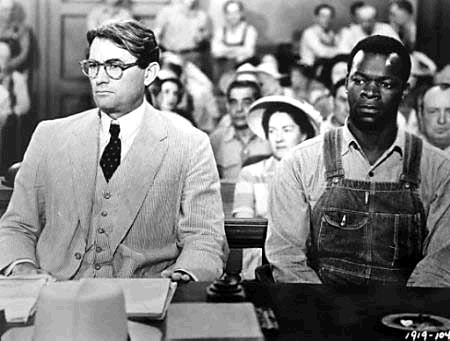Why “To Kill a Mockingbird” should be taught
And the importance of trusting students to make their own decisions

The trial of Tom Robinson from the 1962 classic film adaptation of “To Kill a Mockingbird” (Left to right: Gregory Peck as Atticus Finch and Brock Peters as Tom Robinson) Courtesy of Universal Pictures
When Harper Lee set out to write “To Kill a Mockingbird,” she wasn’t trying to write an average story that taught its lessons through peaceful encounters. It was meant to be controversial. It was meant to make the reader uncomfortable. “To Kill a Mockingbird” was written in 1960, during the peak of the civil rights movement, as Jim Crow laws were finally being deleted from the law books.
After having multiple districts in the nation take the novel off of their curriculum, Biloxi, Mississippi, and the Duluth, Minnesota, it is necessary to understand that the world isn’t always going to be a safe place; schools choosing to shield the children from the kind of language used in books like Lee’s are actually hurting them. It’s better to introduce the disturbing parts of life in a controlled classroom environment that helps prevent students from using the language and enables them to move past it if and when they encounter it in their lives.
The educational value of this book far outweighs the danger that the language used in the book poses. There’s a reason why the book won a Pulitzer after having spent 40 weeks on the bestseller list. Like the other great authors of that century, Lee’s novel helped open the eyes of the American people to the injustice that African-Americans had suffered for decades.
One of the many lessons that could be learned in this book is the fact that despite what Mayella Ewell’s has done during the course of “To Kill a Mockingbird” she is a person still worthy of compassion, and Harper Lee makes sure of that. Like most characters in fiction as well as real life, “Ms. Mayella is not entirely ‘evil’ (or evil at all). She is a multi-faceted human being who has as many positive sides as she does negative ones.”
Her one crime is one that Lee justifies. She is as much of a victim as Tom Robinson was. “What did her father do? We don’t know, but there is circumstantial evidence to indicate that Mayella Ewell was beaten savagely by someone who led almost exclusively with his left…” (204, Lee). With it being implied that Bob Ewell had beaten his daughter at least once, it is only one step further to believe that Mayella feared him. Ms. Mayella Ewell has done what many ordinary people would do in that situation: they would surrender to their fears and hurt someone else, so that they may go unharmed.
Lee only wrote one character who is unredeemable, and that is Robert Ewell, who is just plain evil. Not only does Ewell know that he is committing a crime, he actively tries persecute an innocent man for his own crimes.
Whenever the potentially offensive language shows up, Lee would make sure to reinforce the fact that its usage is negative. If anyone seriously uses the N-word as an insult after reading this book, it wasn’t a result of the book.
“To Kill a Mockingbird” is a revolutionary novel which exposed the large glaring fault of racism in our society in the 1960s. This novel is now more relevant than ever with our country still dealing with segregation and discrimination, but it has managed to survive hidden under the radar. Students should be trusted to read this novel, understand its intricacies and the historical importance of racism, because of the tremendous effect it has had on our society as a whole.
Your donation will support the student journalists of West Linn High School. Your contribution will allow us to continue to produce quality content by purchasing equipment, software, and continuing to host our website on School Newspapers Online (SNO).


























![Game, set, and match. Corbin Atchley, sophomore, high fives Sanam Sidhu, freshman, after a rally with other club members. “I just joined [the club],” Sidhu said. “[I heard about it] on Instagram, they always post about it, I’ve been wanting to come. My parents used to play [net sports] too and they taught us, and then I learned from my brother.”](https://wlhsnow.com/wp-content/uploads/2024/03/MG_7715-2-1200x800.jpg)





![The teams prepare to start another play with just a few minutes left in the first half. The Lions were in the lead at halftime with a score of 27-0. At half time, the team went back to the locker rooms. “[We ate] orange slices,” Malos said. “[Then] our team came out and got the win.”](https://wlhsnow.com/wp-content/uploads/2023/10/IMG_2385-1200x800.jpg)





![At the bottom of the third inning, the Lions are still scoreless. Rowe stands at home plate, preparing to bat, while Vandenbrink stands off to the side as the next batter up. Despite having the bases loaded, the team was unable to score any runs. “It’s just the beginning of the season. We’re just going to be playing out best by June, [and] that’s where champions are,” Rowe said.](https://wlhsnow.com/wp-content/uploads/2024/03/IMG_3077-1200x900.jpg)
















































































bull dozer
Feb 16, 2023 at 8:49 am
this book is ass
Dd
Mar 16, 2023 at 7:53 am
It’s a good book. If you can interpret it more than just read it then you’d understand.
Justin
Apr 11, 2023 at 10:07 am
?